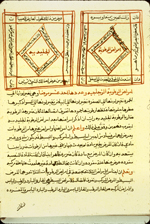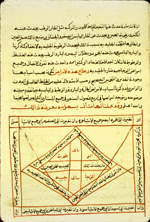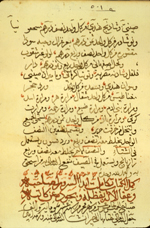Catalogue: Medical Monographs
-
 Fawā’id min Kitāb Tadqīq al-nazar fī ‘ilm ḥāssat al-baṣar (MS A 3/II, item 3)
Fawā’id min Kitāb Tadqīq al-nazar fī ‘ilm ḥāssat al-baṣar (MS A 3/II, item 3) - (Useful Lessons from the Book "Accuracy of Examination into Knowledge of the Sense of Vision")
- فوائد من كتاب تدقيق النظر فى علم حاسة البصر
- by ‘Abd al-Karīm Ibn Wāfid al-Lakhmī (d. 1074/467)]
- عبد الكريم ابن وافد اللخمى
The Spanish physician Ibn Wāfid al-Lakhmī was known to have written a treatise on various ocular deficiencies and their treatment which was titled Kitāb Tadqīq al-nazar fīi ‘ilm ḥāssat al-baṣar (The Book of the Accuracy of Examination into Knowledge of the Sense of Vision) or Kitāb Tadqīq al-nazar fī ‘ilal ḥāssat al-baṣar (The Book of the Accuracy of Examination into the Deficiencies of the Sense of Vision). Later writers on ophthalmology usually referred to the treatise by Ibn Wāfid al-Lakhmī by the second form of the title, which substitutes the word ‘ilal (deficiencies) for ‘ilm (knowledge,); see Ullmann, Medizin, p. 210.
In the NLM copy, the book from which these "useful lessons" (fawa'id) are derived is given the title Kitāb Tadqīq al-nazar fīi ‘ilm ḥāssat al-baṣar. The text preserved in this unique manuscript concerns the causes and treatment of weakness of vision (du‘f al-basar). The author is not named in the manuscript, but given the distinctive title and the subject matter, the attribution to Ibn Wāfid al-Lakhmī seems reasonable.
Except for the fragment contained in the NLM manuscript, the treatise is now lost. No other copy is recorded.
The treatise has not been published or translated.
Fawā’id min Kitāb Tadqīq al-nazar fī ‘ilm ḥāssat al-baṣar (MS A 3/II, item 3)
Illustrations
The lower third of this folio contains the beginning of an Arabic treatise on weakness of vision and its treatment, apparently by the Spanish physician Ibn Wāfid al-Lakhmī, who died in 1074/467. This fragmentary copy is the only part of the treatise preserved today. Undated copy, probably 13th-14th century.
The second page of an Arabic treatise on weakness of vision and its treatment, apparently by the Spanish physician Ibn Wāfid al-Lakhmī, who died in 1074/467. This fragmentary copy is the only part of the treatise preserved today. Undated copy, probably 13th-14th century.
Physical Description
Arabic. 2 leaves (fols. 7a-8b [old 6a-7b]). The text begins at line 15 of fol. 7a; on fol. 8b the end of the text occupies the top third of the page and the rest has been filled in by later owners. Dimensions 17.2 x 13.1 (approx. text area 15 x 11) cm; 27 lines per page. The title is given on fol. 7a [old 6a], line 15, as Fawā’id min Kitāb Tadqīq al-nazar fī ‘ilm ḥāssat al-baṣar. The author is not named; on line 16 of fol. 7a it says merely qala al-hukama' (the doctors said). Given the distinctive title and subject matter, the attribution to Ibn Wafid seems reasonable.
The copy is undated and unsigned. The appearance of the paper, script, and ink suggests a date of the 13th of 14th centuries.
The text is written in a small, compact naskh script, possibly by the same hand as copied item 2 in the volume. The text area has not been frame-ruled and the lines are irregularly positioned. It is written in brown-black ink. Many of the diacritical dots are missing.
There are no marginalia, though the lower two-thirds of fol. 8b [old 7b] is filled with later owners' annotations, written upside down. These consist of a four-line poem in mutaqarib meter; it appears to be a moralistic epigram of some sort (assuming the person being addressed is God), beginning (in translation):
"Whatever You wish, is, even though I wish [it] not; But whatever I wish, if You do not wish [it], is not."
Beneath the poem, written in a a different hand, are two and a half lines (abutting upon the final line of the Ibn Samajun text, but written upside down) stating that the accounts were finished for one Ḥasan al-Khanī up to the end of the month of Rabi‘ I in the year [..]39 and signed (‘alá yadd, "in the hand of") al-Ḥājj ‘Abd Allāh al-‘Attar [the druggist]. A vertical, much damaged, annotation again mentions Ḥasan al-Khanī, and above the four-line poem (at the bottom of fol. 8b) are several lines of calculations, possibly by the same hand as wrote the vertical note. [The assistance of Professor Geert Jan van Gelder, of the Oriental Institute, Oxford, with reading the poem is here gratefully acknowledged.]
The opaque biscuit paper is water damaged, especially near the edges, and there are areas within the text area that are damaged and illegible. The folios have been trimmed from their original size, occasionally cutting off parts of the text.
The volume consists of 8 folios and one end leaf. There is an earlier foliation in Arabic numerals which omits to number the first folio and places Arabic numerals 1-7 on what are fols. 2-8 in the recent foliation. Item 1 (fols. 1a-4a [old [1]a-3a]) is the al-Risālah al-Shāfiyah fi adwiyat al-nisyān by Isḥāq ibn Ḥunayn (MS A 3/II, item 1); item 2 (fols. 4b-7a line 14 [old 3b-6a]) is an untitled collection of drug recipes by Ibn Samajūn (MS A 3/II, item 2); and item 3 (fols. 7a-8b [old 6b-7b]) is the item here catalogued. The end leaf, of slightly different paper, has casually written notes, the first being eight lines, with some words marked out, on an unidentified topic; beneath the eight lines a different hand has written an account (that extends to both sides of the leaf) of a procedure for making an effective purgative (tuhr) employing various earths; the account begins with the date (ta’rikh) of 8 Rajab 981 [= 3 November 1573].
Binding
The collection of three treatises is bound together with another manuscript (designated MS A 3/I), copied at the end of the 15th century, which contains two items concerned with compound remedies. The 8 leaves of MS A 3/II had separate foliation in Arabic numerals and are considerably older that the manuscript with which it is bound; were the volume to be foliated straight through, then these eight leaves and one end leaf would be counted as fols. 70-78 of the bound volume.
Provenance
On fol. 8b [old 8b] one al-Ḥājj ‘Abd Allāh al-‘Attar has added a note (upsidedown on the page) that he closed the accounts of one Ḥasan al-Khanī at the end of the month Rabi‘ I in the year [-]39 (the century is not specified); and different later owner has dated a procedure for making an effective purgative the 8th of Rajab 981 [= 3 November 1573].
The volume was purchased in 1941 by the Army Medical Library from A.S. Yahuda, who acquired it from a dealer in Mosul in Iraq (ELS no. 1750; Med. 51).
References
Schullian/Sommer, Cat. of incun. & MSS., entry A 3, p. 298 (this item is not mentioned).
NLM Microfilm Reel: FILM 48-110 no. 3.
-
 Kitāb Natījat al-fikar fī ‘ilāj amrāḍ al-baṣar (MS A 48)
Kitāb Natījat al-fikar fī ‘ilāj amrāḍ al-baṣar (MS A 48) - (The Result of Thinking about the Cure of Eye Disease)
- كتاب نتيجة الفكر فى علاج امراض البصر
- by Fatḥ al-Dīn (ibn ‘Uthmān ibn Hibat Allāh) al-Qaysī (d. 1258/657)
- فتح الدين ابن عثمان ابن هبة الله القيسى
Fatḥ al-Dīn al-Qaysī composed his ophthalmological manual in Cairo and dedicated it to the Egyptian Ayyubid ruler al-Malik al-Salih II Najm al-Dīn Ayyub, who ruled from 1240 to 1249. It consists of seventeen chapters dealing with the anatomy and physiology of the eye and with the causes, symptoms, and treatment of 124 eye conditions, some apparently described here for the first time.
The NLM copy was one of five copies forming the basis of the German translation and commentary by Hans-Dieter Bischoff, Das Ergebnis des Nachdenkens ueber die Behandlung der Augenkrankheiten von Fath ad-Din al-Qaisi [Europaische Hochschulschriften; Asiatische und Afrikanische Studien, no. 27] (Frankfurt am Main and New York: Peter Lang, 1988).
Fourteen copies are known to be preserved today. For other copies, see Bischoff citd above, and Ullmann, Medizin, p. 212 note 2; and GAL-S vol. 1, p. 897.
The Arabic text remains unpublished.
Kitāb Natījat al-fikar fī ‘ilāj amrāḍ al-baṣar (MS A 48)
Illustrations
The beginning of the ophthalmological manual by Fatḥ al-Dīn al-Qaysī dedicated to the Ayyubid ruler of Egypt from 1240 to 1249. The copy was completed on 5 Jumadá I 907 [16 November 1501].
The colophon of the ophthalmological manual by Fatḥ al-Dīn al-Qaysī dedicated to the Ayyubid ruler of Egypt from 1240 to 1249. In line 14 it states that the copy was completed on 5 Jumadá I 907 [16 November 1501].
A diagram illustrating stages of visual acuity from the ophthalmological manual by Fatḥ al-Dīn al-Qaysī dedicated to the Ayyubid ruler of Egypt from 1240 to 1249. The copy was completed on 5 Jumadá I 907 [ 16 November 1501].
Physical Description
Arabic. 34 leaves (fols. 2a-35a). Dimensions (17.8 x 12.5 (text area 16.2 x 10.2, varying) cm; 24-25 lines per page (except fols. 5 (27-28 lines) 6 (30 lines), 7a (32), 7b (33), 8a (34), and 8b (43 lines). The author's name is given as Fatḥ al-Dīn Abū al-Fatḥ Aḥmad ibn al-Qadi Jamal al-Dīn ‘Uthmān ibn Hibat Allāh on the title page (fol. 2a) and the beginning of the treatise (fol. 2b, lines 4-5). The title is given near the start of the text, lines 1-2 of fol. 2b; a shorter form is given on the title page (fol. 2a): Kitāb Natījat al-fikar fī amrāḍ al-baṣar.
The copy is dated in the colophon (fol. 35a [old 92a]), line 14, where it is said that the unnamed copyist completed it on 5 Jumadá I 907 [16 November 1501]. The year given could be read as either 907 or 707, but the year 907 seems more likely given the general appearance of the manuscript. The copyist is not named.
A complete copy. The text is written in a small, compact naskh (a Turkish hand ?) in black ink with headings in red and red overlinings. The text area has been frame-ruled. There are catchwords. Fols. 5-6 were transcribed by a different copyist, and fols. 7-8 by yet another copyist. Fols. 5-8 are replacement leaves, not frame-ruled, by different copyists; on fols. 7-8 the margins are indicated with penciled lines. This copy was at one time apparently part of another volume, for the folios have been numbered in Arabic numerals (beginning with the second folio of the volume) from 61 to 92; the volume has recently been renumbered in Western numerals.
On fol. 23b [old 78b] there is a diagram representing stages of visual acuity, drawn in red and black ink.
There are marginalia in several hands, some emending the text and some in Turkish.
The biscuit, thick, opaque paper (of fols. 2-4 and 9-35) has laid lines that are barely visible. Replacement folios 5-8 are watermarked paper. Some folios have been repaired. The folios have been trimmed from their original size.
The volume consists of 35 leaves. Fol. 1a is blank; fol. 1b contains a poem and miscellaneous notes. A later astrological chart giving zodiacal signs and elements has been added to the title page (fol. 2a) along with miscellaneous notes. The lower half of 35a and all of 35b are filled with recipes and Turkish notes.
Binding
The volume is bound in a modern library binding of tan leather. There are modern paper pastedowns and endpapers.
Provenance
The volume was purchased in 1941 by the Army Medical Library from A.S. Yahuda who bought it in Tanta, Egypt (ELS 2376).
References
Schullian/Sommer, Cat. of incun.& MSS., entry A 48, p. 313 where the date of the copy is read as 907.
C.F. Mayer, Bulletin of the History of Medicine, vol. 11 (1942), p. 214, where the date of the copy is read as 707.
NLM Microfilm Reel: FILM 48-121 no. 5.
-
 Kitāb al-‘Umdah al-kuḥlīyah fī al-amrāḍ al-baṣarīyah
Kitāb al-‘Umdah al-kuḥlīyah fī al-amrāḍ al-baṣarīyah - or al-‘Umdah al-nuriyah fī al-amrāḍ al-baṣarīyah (MS A 29.1)
- (The Ophthalmological Principle in Diseases of the Visual System)
- كتاب العمدة الكحلية فى المراض البصرية
- by Ṣadaqah ibn Ibrāhīm (al-Ḥanafī al-Miṣrī) al-Shadhilī (14th cent.)
- صدقه ابن ابراهيم الشذلى الحنفى المصرى
The Egyptian oculist Ṣadaqah ibn Ibrāhīm al-Shadhilī composed his ophthalmological manual late in the 14th century. It contains some interesting evidence as to the level and frequency of ocular surgery in his day. The treatise, according to the introduction, consisted of five sections (jumlahs), each divided into subsections (fasls).
The NLM manuscript is an incomplete copy made in Syria or Egypt sometime before an owner's entry written in 1135 H (= 1723 AD).
Three other copies are known and they also are incomplete: Munich, Bayerische Staatsbibliothek, cod. arab. 834; Dublin, Chester Beatty Library, Arabic MS 3990; and St Petersburg, Peterhouse 175. Small portions of the latter copy have been published; see Victor Rosen, Les manuscripts arabes de l'Institut des Langues Orientales [Collections Scientifiques de l'Institut des Langues Orientales du Ministère des Affaires Étrangères, no. 1] (Saint-Pétersbourg, 1877; reprinted Amsterdam: Celibus N.V., 1971), pp. 100-109. See also Ullmann, Medizin, p. 214 note 1.
For an edition, translation and study of one chapter, on cataracts, see E. Savage-Smith and B. Inksetter, "Could medieval Islamic oculists remove cataracts? -- the views of a 14th-century skeptic" (forthcoming). The text has not otherwise been published.
Kitāb al-‘Umdah al-kuḥlīyah fī al-amrāḍ al-baṣarīyah (MS A 29.1)
Illustrations
Visual acuity diagrams from the ophthalmological manual written in Egypt toward the end of the 14th century by Ṣadaqah ibn Ibrāhīm al-Shadhilī. The undated copy was completed sometime before an owner's note was placed in the volume in 1723/1135.
Physical Description
Arabic. 152 leaves (fol. 2a-153b). Dimensions 19.8 x 15.1 (text area 15.4 and 10.7) cm; 21 lines per page. The author's name is given on the title page (fol. 1a) as Ṣadaqah ibn Ibrāhīm al-Shadhilī al-Ḥanafī. The title given at the beginning of the text (fol. 2a, line 13) is al-‘Umdah al-kuḥlīyah fī al-amrāḍ al-baṣarīyah, while the title page (fol. 1a) has the variant title al-‘Umdah al-nuriyah fī al-amrāḍ al-baṣarīyah.
The copy is undated and unsigned. The appearance of the paper, script, and ink suggests a date of the 17th century. The copy had to have been completed before an owner's note dated 8 Rajab 1135 [ 14 April 1723] was placed on the title page (fol. 1a).
An incomplete copy which breaks off in the tenth chapter (fasl) of the fourth section (jumlah). The text is written in a medium-large, clear naskh script in black ink with headings in red. There are catchwords. It was previously paginated in Arabic numerals, and it has been recently refoliated.
There are charts and diagrams on fols. 50a, 121a, 126b and 127a .
There are marginal corrections and it has been collated. There are penciled English notes in the margins and bibliographic notes in German on the front pastedowns.
The volume consists of 153 leaves and two preliminary leaves. Fol. 1b is blank; fol. 1a is the title page and is contemporaneous with the copy of the text. The first preliminary leaf is blank. The second preliminary leaf is older than the first and is blank except for a shortened form of the title and author.
Binding
The volume is bound in a Middle Eastern library binding with cloth-covered pasteboards and a leather spine. There is evidence on the second preliminary leaf that at one time the manuscript was in a binding with an envelope flap. The edges of the pages are marbled.
Provenance
An owner's note dated 8 Rajab 1135 [= 14 April 1723] occurs on the title page (fol. 1a).
It may formerly have been in the collection of the ophthalmologist and historian Max Meyerhof (d. 1945), for it appears to contain his annotations.
It was purchased by the National Library of Medicine in 1944 from Salomon S. Meyer, a dealer in Amsterdam (sale catalog: Pampiera Wereld: Salomon S. Meyer, Antiquaariaat-Graphiek, Hebraica-Judaica, Amsterdam, no. 82-15863).
References
Unrecorded
[not in Schullian/Sommer, Cat. of incun. & MSS.]
-
 Istibṣār
fī ‘ilāj amrāḍ al-abṣār (MS A 23)
Istibṣār
fī ‘ilāj amrāḍ al-abṣār (MS A 23) - (Reflection on the Treatment of Ocular Diseases)
- استبصار فى علاج امراض الابصار
- by Ibrāhīm ibn Abī Ṭālib ibn ‘Alī al-Ḥanafī (17th cent. ?)
- ابراهيم ابن ابى طالب ابن على الحنفى
Ibrāhīm ibn Abī Ṭālib ibn ‘Alī al-Ḥanafī composed his ophthalmological manual sometime before 1698 [1110 H] when the unique copy now at NLM was completed. The treatise is divided into four chapters (fanns): the first on the anatomy and function of the eye (fols. 1a-4b), the second on external and visible diseases of the eye (fols. 4b-31a); the third on hidden diseases of the eye (fols. 31a-42a); and the final one on compound ocular remedies (fols. 42b-51a).
No other copy is recorded.
The text has not been published or translated.
Istibṣār fī ‘ilāj amrāḍ al-abṣār (MS A 23)
Illustrations
Part of the colophon at the end of the ophthalmological manual by an otherwise unknown physician named Ibrāhīm ibn Abī Ṭālib ibn ‘Alī al-Ḥanafī. The copy was completed by an unnamed copyist on 5 Muharram 1110 [ 24 July 1698].
Physical Description
Arabic. 51 leaves (fols. 1a-51b). Dimensions 21.8 x 15.7 (text area 17.0 x 9.5) cm; 17-18 lines per page. The author is named at the start of the text (fol. 1a lines 2-3) and again on the final folio (fols. 51b lines 3-5) as Ibrahim ibn Abi Talib ibn ‘Ali al-Hanafi al-mutatabbib [the medical practitioner]. The title is given near the start of the text (fol. 1b lines 1-2) as Istibsar fi ‘ilaj amrad al-absar; a variant of the title (Istibṣār fī ‘ilāj al-‘ayn lil-basar appears on the last folio (fol. 51b lines 1-2), which has the format of a title page. Short versions of the title (Kitab al-istibṣār) occur throughout (e.g., fol. 31a line 1, fols. 4b line 12, and fol. 50b line 12).
The copy is dated in the colophon (fol. 51a line 17) where it states that an unnamed copyist completed it on 5 Muharram 1110 (24 July 1698).
A complete copy. The text is written in a medium-large naskh script in black ink with headings in red. There are catchwords. The leaves have Arabic numerals 403-502 on them, indicating that it was at one time part of a larger volume; the volume is now renumbered in Western numerals.
There are some penciled marginalia, with occasional corrections to the text.
The stiff, cream paper has visible laid lines and single chain lines. The paper is yellowed near the edges.
The volume consists of 51 leaves.
Binding
The volume is bound in marbled paper over pasteboards with a red-leather spine. There are modern paper pastedowns and endpapers.
Provenance
The volume was purchased by the Army Medical Library in 1941 from A.S.Yahuda who acquired it in Cairo (ELS no. 1665).
References
Schullian/Sommer, Cat. of incun. & MSS., entry A 23, pp. 204-5.
NLM Microfilm Reel: FILM 48-116 no. 5

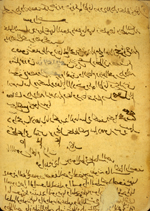
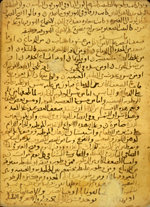
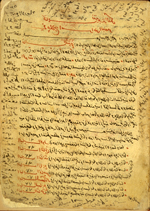
![MS A 48, fol. 35a [old 92a] Folio 35a from al-Qaysī's Kitāb Natījat al-fikar fī ‘ilāj amrāḍ al-baṣar (The Result of Thinking about the Cure of Eye Disease) featuring the colophon. The biscuit, thick, opaque paper has laid lines. The text is written in a small, compact naskh in black ink with headings in red and red overlinings.](images/a4835aThumb.jpg)
![MS A 48, fol. 23b [old 78b] Folio 23b from al-Qaysī's Kitāb Natījat al-fikar fī ‘ilāj amrāḍ al-baṣar (The Result of Thinking about the Cure of Eye Disease) which features a diagram illustrating stages of visual acuity. The biscuit, thick, opaque paper has laid lines. The text is written in a small, compact naskh in black ink with headings in red and red overlinings.](images/a4823bThumb.jpg)
